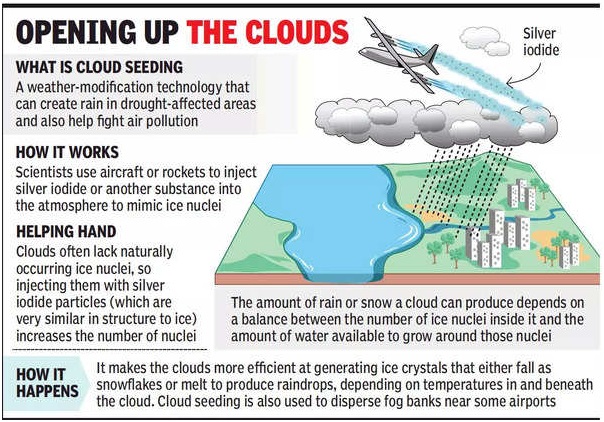Cloud Seeding (LiveMint)

- 14 Nov 2023
Why in the News?
The Delhi government is mulling the use of artificial rain through cloud seeding this month to combat the air pollution crisis in the national capital.
What is Cloud Seeding?
- Cloud seeding is a weather modification technique aimed at increasing precipitation by dispersing substances into the air that serve as cloud condensation or ice nuclei.
- The primary goal is to encourage the formation and growth of precipitation particles within clouds.
- Commonly used substances for cloud seeding include silver iodide, potassium iodide, and liquid propane.
There are two main types of cloud seeding:
- Static cloud seeding: This type of seeding is used to increase precipitation in areas that are experiencing drought
- It involves releasing silver iodide or dry ice into clouds that are already producing precipitation.
- The silver iodide or dry ice acts as ice nuclei, which causes water droplets in the clouds to freeze and form snowflakes.
- The snowflakes then grow larger and fall to the ground as rain or snow.
- Dynamic cloud seeding: This type of seeding is used to increase the amount of precipitation that falls from clouds that are not yet producing precipitation.
- It involves releasing silver iodide into clouds that are still in the development stage.
- The silver iodide acts as condensation nuclei, which causes water vapor in the clouds to condense and form water droplets.
- The water droplets then grow larger and fall to the ground as rain or snow.
- Cloud seeding is typically done using aircraft, but it can also be done using ground-based generators or rockets.
- The aircraft or other seeding platform will fly into the clouds and release the silver iodide or dry ice.
- The seeding material will then spread throughout the cloud and begin to alter the microphysical processes.
- The effectiveness of cloud seeding is debated.
- Some studies have shown that it can increase precipitation by up to 30%, while other studies have shown that it has little or no effect.
- The effectiveness of cloud seeding is likely to vary depending on the type of clouds being seeded, the atmospheric conditions, and the seeding method used.
- Cloud seeding is used in a variety of countries around the world, including the United States, China, Russia, and Australia.
